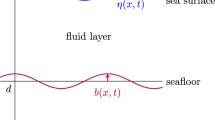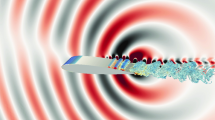Abstract
In the present work, non-linear wave loads acting on large floating structures are computed using a 3D numerical wave tank (NWT) approach in an approximate manner. The hydrodynamic initial boundary value problem is solved following a Rankine panel-based boundary element method in conjunction with time integration of free-surface constraints and body-motion equations. To enable long-duration simulation for practical offshore configurations, total velocity potential is split into incident and perturbation part, and the latter effects are linearized. In our earlier works (Ganesan and Sen in J Ocean Eng Mar Energy 1:299–324, 2015; Ganesan and Sen in Appl Ocean Res 51:153–170, 2015), the 2nd order contributions from the linearized perturbation potential were neglected. In this work, we propose a modified formulation for the external load in which the full non-linear loads from the incident wave and up to 2nd order loads from the linear perturbation potential are considered. After presenting some results to validate the present method for steady drift force computations, non-linear loads from the modified formulation are compared with the unmodified form of the method and also with widely used 3D frequency-domain Green-function-based method. Comparative results between these three computations are presented for different geometries and the results are discussed to bring out the relative advantage of the modified formulation in predicting non-linear loads across the range of frequency and wave steepness.



























Similar content being viewed by others
References
A. Abasania, C. Guedes Soares, Exact evaluation of hydrodynamic loads on ships using NURBS surface and acceleration potential. Eng. Anal. Bound. Elem. 85, 1–12 (2017)
A. Abasania, C. Guedes Soares, Transient fully nonlinear ship waves using a three-dimensional NURBS numerical towing tank. Eng. Anal. Bound. Elem. 91, 44–49 (2018)
W. Bai, R. Eatock-Taylor, Higher order boundary element simulation of fully nonlinear wave radiation by oscillating vertical cylinders. Appl. Ocean Res. 28, 247–265 (2006)
W. Bai, R. Eatock-Taylor, Numerical simulation of fully nonlinear regular and focused wave diffraction around vertical cylinder using domain decomposition. Appl. Ocean Res. 29, 55–71 (2007)
W. Bai, R. Eatock-Taylor, Fully nonlinear simulation of wave interaction with fixed and floating flared structures. Ocean Eng. 36(3), 223–236 (2009)
W. Bai, B. Teng, Simulation of second-order wave interaction with fixed and floating structures in time domain. Ocean Eng. 74, 168–177 (2013)
P.J. Bandyk, R.F. Beck, The acceleration potential in fluid-body interaction problems. J. Eng. Math. 70, 147–163 (2011)
F.P. Chau, R. Eatock-Taylor, Second-order wave diffraction by a vertical cylinder. J. Fluid Mech. 240, 571–579 (1992)
Y.R. Choi, S.Y. Hong, H.S. Choi, An analysis of second-order wave forces on floating bodies by using a higher-order boundary element method. Ocean Eng. 28(1), 117–138 (2000)
R. Cointe, P. Geyer, B. King, B. Molin, M. Tramoni, Nonlinear and linear motion of a rectangular barge in a perfect fluid. In Proceedings of the 18th Symposium on Naval Hydrodynamics (National Academy Press, Washington DC, 1991), pp. 85–99
R. Eatock-Taylor, S.M. Hung, Second order diffraction forces on a vertical cylinder in regular waves. Appl. Ocean Res. 9(1), 19–30 (1987)
X. Feng, W. Bai, Wave resonances in a narrow gap between two barges using fully nonlinear numerical simulation. Appl. Ocean Res. 50, 119–129 (2015)
A. Feng, Z.-M. Chen, W.G.A. Price, Rankine source computation for three dimensional wave-body interactions adopting a nonlinear body boundary condition. Appl. Ocean Res. 47, 313–321 (2014)
P. Ferrant, Simulation of strongly nonlinear wave generation and wave-body interactions using a 3-D MEL Model. In Proceedings of the 21st Symposium on Naval Hydrodynamics 1997 (National Academy Press), pp. 93–109
P. Ferrant, D.L. Touzé, K. Pelletier, Non-linear time-domain models for irregular wave diffraction about offshore structures. Int. J. Numer. Methods Fluids 43(10–11), 1257–1277 (2003)
T.S. Ganesan, D. Sen, Time-domain simulation of large-amplitude wave–structure interactions by a 3D numerical tank approach. J. Ocean Eng. Mar. Energy 1, 299–324 (2015)
T.S. Ganesan, D. Sen, Direct time domain analysis of floating structures with linear and nonlinear mooring stiffness in a 3D numerical wave tank. Appl. Ocean Res. 51, 153–170 (2015)
T.S. Ganesan, Development of a generalised 3D numerical wave tank for steep wave interactions with floating bodies. Ph.D. Thesis (IIT Kharagpur-Indian Institute of Technology Kharagpur, 2016)
S.E. Hiradis, W. Bai, D. Dessi, A. Ergin, X. Gi, O.A. Hermundstad, R. Huijsmans, K. Iijima, U.D. Neilson, J. Parunov, N. Fonseca, A. Papanikolaou, K. Argyriadis, A. Incecik, Loads for use in the design of ships and offshore strictures. Ocean Eng. 78, 131–174 (2014)
M. Isaacson, K.F. Cheung, Second order wave diffraction around two-dimensional bodies by time-domain method. Appl. Ocean Res. 13(4), 175–186 (1991)
J.M.J. Journee, W.W. Massie, Offshore Hydrodynamics (Delft University of Technology, Delft, 2001)
C.H. Kim, Nonlinear Waves and Offshore Structures, vol. 27, Advanced Series in Ocean Engineering (World Scientific, Singapore, 2008)
M.W. Kim, W. Koo, S.Y. Hong, Numerical analysis of various artificial damping schemes in a three-dimensional numerical tank. Ocean Eng. 75, 165–173 (2014)
Y. Kim, D.C. Kring, P.D. Sclavounos, Linear and nonlinear interaction of surface waves with bodies by a three-dimensional panel method. Appl. Ocean Res. 19, 235–249 (1997)
W.C. Koo, M.H. Kim, Fully nonlinear wave-body interactions with surface-piercing bodies. Ocean Eng. 34(7), 1000–1012 (2007)
C.H. Lee, X. Zhu, Second-order diffraction and radiation solutions on floating bodies. In 8th Int’l Workshop on Water Waves and Floating Bodies 1993. St. John’s, Newfoundland, Canada
M.S. Longuet-Higgins, E.D. Cokelet, The deformation of steep surface waves on water. I. A numerical method of computation. Proc. R. Soc. Lond. A Math. Phys. Sci. 350(1660), 1–26 (1976)
B. Molin, Second-order diffraction loads upon three-dimensional bodies. Appl. Ocean Res. 1, 197–202 (1979)
J.Y. Ng, M. Isaacson, Second-order wave interaction with two-dimensional floating bodies by a time-domain method. Appl. Ocean Res. 15(2), 95–105 (1993)
N. Nojiri, K. Murayama, A study on the drift force on two-dimensional floating body in regular waves. Trans. West Jpn. Soc. Nav. Archit. 51, 131–152 (1975)
J.A. Pinkster, Low frequency Second order wave exciting forces on floating structures. Ph.D. Dissertation (Delft University of Technology, 1980)
M.M. Rienecker, J.D. Fenton, A Fourier approximation method for steady water waves. J. Fluid Mech. 104, 119–137 (1981)
F. Ruggeri, R.A. Watai, C.M.P. Sampaio, A.N. Simos, On the development of a higher order time-domain Rankine panel method for linear and weakly non-linear seakeeping computations. J. Braz. Soc. Mech. Sci. Eng. (2018). https://doi.org/10.1007/s40430-017-09333-3
D. Sen, Efficient computation of influence coefficients in Rankine panel based methods of computational ship hydrodynamics. Ocean. Eng. Int. 5, 16–30 (2000)
D. Sen, Time-domain simulation of motions of large structures in nonlinear waves. In 21st International OMAE Conference 2002a. Oslo, Norway, pp. 7–17
D. Sen, Time-domain computation of large amplitude 3D ship motions with forward speed. Ocean Eng. 29, 973–1002 (2002)
R.A. Watai, F. Ruggeri, C.M.P. Sampaio, A.N. Simos, Development of a time domain boundary element method for numerical analysis of floating bodies’ response in waves. J. Braz. Soc. Mech. Sci. Eng. (2015). https://doi.org/10.1007/s40430-015-0369-6
R.A. Watai, Dinoi, F. Ruggeri, A. Souto-Iglesias, A.N. Simos, Rankine time-domain method with application to side-by-side gap flow modeling. Appl. Ocean Res. 50, 69–90 (2015)
R.A. Watai, F. Ruggeri, A.N. Simos, A new time-domain Rankine panel method for simulations involving multiple bodies with large relative displacements. Appl. Ocean Res. 59, 93–114 (2016)
Author information
Authors and Affiliations
Corresponding author
Additional information
Publisher's Note
Springer Nature remains neutral with regard to jurisdictional claims in published maps and institutional affiliations.
Rights and permissions
About this article
Cite this article
Shivaji Ganesan, T., Sen, D. Prediction of non-linear wave loads on large floating structures using a 3D numerical wave tank approach. Mar Syst Ocean Technol 14, 129–152 (2019). https://doi.org/10.1007/s40868-019-00062-3
Received:
Accepted:
Published:
Issue Date:
DOI: https://doi.org/10.1007/s40868-019-00062-3




